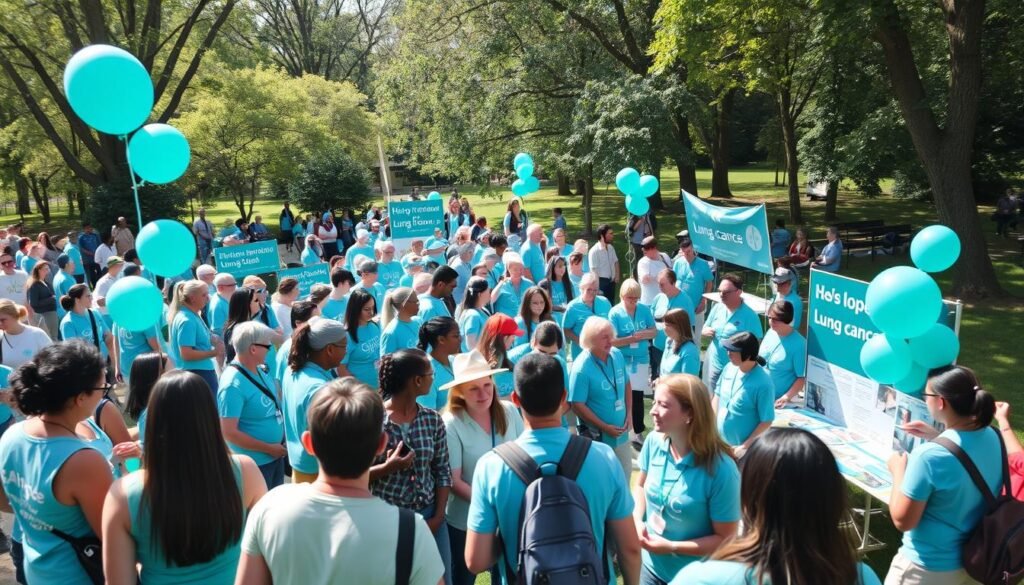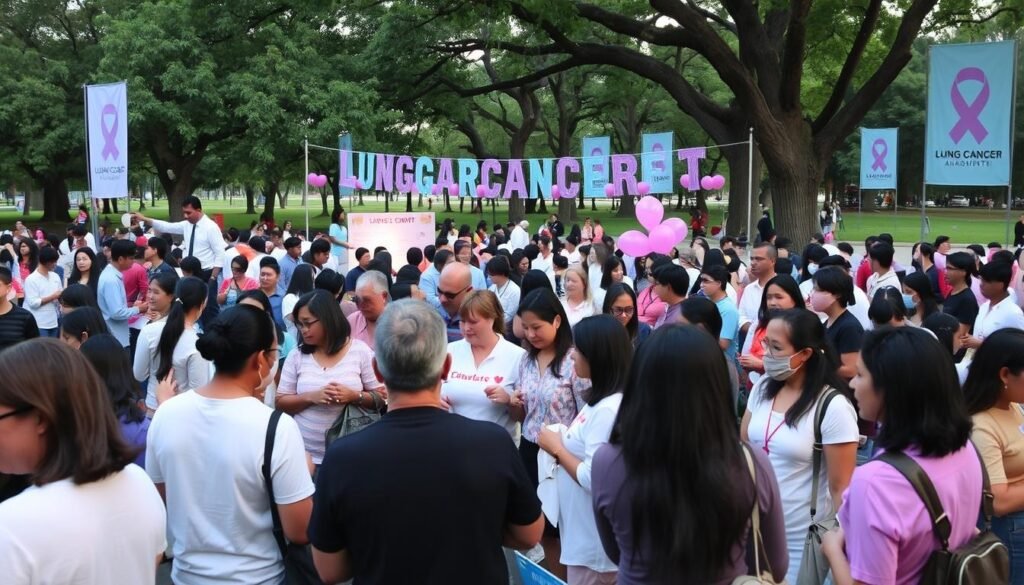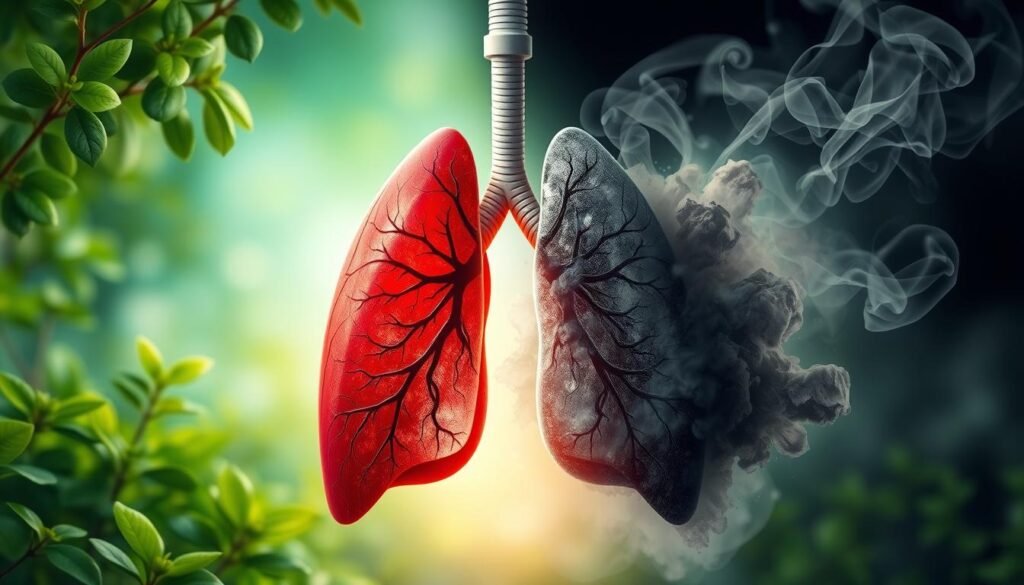Lung cancer is not just the most common cancer; it’s the most deadly. It causes more deaths than breast, prostate, and colorectal cancers combined. This shows how campaigns and initiatives for lung cancer awareness are crucial. Organizations work hard to educate people, raise research funds, and advocate for early detection and treatment.
The LUNGevity Foundation’s “Anyone with Lungs Can Get Lung Cancer” campaign is making a difference. It fights common misconceptions and encourages everyone to take action. They use community events, social media, and a special awareness store to push forward lung cancer advocacy and improve patient care.
The IASLC has given over $14 million for lung cancer research in 20 years. People joining these efforts help enhance patient outcomes greatly. During awareness months, we all should take part. Doing so helps highlight the importance of fundraising and advocacy for lung cancer, leading to a healthier future.
Key Takeaways
- Lung cancer is the leading cause of cancer death globally, necessitating awareness and educational initiatives.
- Support for lung cancer research is vital, with millions awarded for advancements in patient care.
- Active community involvement can significantly enhance the impact of lung cancer awareness campaigns.
- Advocacy efforts challenge misconceptions about lung cancer, emphasizing that anyone with lungs is at risk.
- Participating in campaigns like Lung Cancer Awareness Month can make a difference in public education and support access to care.
Understanding Lung Cancer and Its Impact
Lung cancer is a major health problem in the United States. It affects a lot of people. About 1 in 18 Americans will face lung cancer in their lives. Each year, doctors diagnose over 234,000 new cases.
Understanding lung cancer is crucial. Both non-smokers and those who have quit smoking can get this disease.
Statistics on Lung Cancer in the U.S.
- Non-Small Cell Lung Cancer (NSCLC) accounts for around 85% of all lung cancer cases.
- In 2021, the U.S. recorded 209,500 new cases of lung cancer.
- The death toll for lung cancer in 2022 reached 131,888 individuals.
- 30 out of every 100,000 people died from lung and bronchus cancer in 2022, representing the highest death rate among cancers.
- Only 18% of eligible individuals are up to date with their lung cancer screenings.
- Screening with annual low-dose CT scans can reduce the lung cancer death rate by up to 20%.
Common Misconceptions about Lung Cancer
There are many myths about lung cancer. These myths can prevent people from getting the help they need. For example, not just smokers get lung cancer. About 2,900 non-smokers get it every year from radon exposure.
It’s important to know the risks and signs of lung cancer. Symptoms like constant coughing, trouble breathing, and losing weight without trying need attention. By clearing up these myths, we can help more people understand lung cancer better. This leads to healthier lives and on-time medical care.
| Statistic | Data |
|---|---|
| Annual New Cases | 234,000 |
| Annual Deaths (2022) | 131,888 |
| Death Rate per 100,000 | 30 |
| Non-Small Cell Lung Cancer Cases | 85% |
| Eligible Individuals Up to Date with Screening | 18% |
Campaigns and Initiatives for Lung Cancer Awareness
Lung cancer awareness campaigns are crucial. They teach people about the disease, push for early detection, and call for research funds. Organizations have started key projects to raise awareness. Among them is the “Plus One” campaign. It hopes to reach up to 50 different places in the U.S. within three years. The goal is to increase screening rates. Right now, less than 5% of those who should get screened actually do.
Overview of Major Campaigns
Many powerful campaigns focus on lung cancer awareness. The Lung Cancer Research Foundation (LCRF) has given 416 grants. This added up to almost $43 million to help find better treatments and ways to prevent lung cancer. The Lung Cancer Initiative has also been active. They donated over $400,000 for research in 2023 alone. Additionally, they hold educational events, like those about radon. These efforts highlight how key public awareness is in fighting lung cancer.
Importance of Public Participation
When the public gets involved in lung cancer efforts, it really helps. It spreads the word about how serious this disease is. Sadly, about 125,070 Americans might die from lung cancer in 2024. Projects such as the gas card initiative show how community efforts can create change. By getting involved, people support education, push for more screenings, and fund research. This all aids in the battle against lung cancer.
LUNG FORCE: A Leading Lung Cancer Advocacy Campaign
LUNG FORCE is a key player in the fight against lung cancer. It has built a dedicated community to increase awareness and fund crucial research. It has hosted many events to bring advocates and lawmakers together. These efforts have paid off, especially during Advocacy Days in Washington, D.C.
Thanks to these efforts, federal funding for lung cancer research has soared by 140% since 2014. Over $30 million has been raised for research. Clearly, LUNG FORCE advocacy is making a major difference in combating this serious health issue.
Events and Activities in Advocacy Days
Advocacy Days are vital for LUNG FORCE efforts. They bring advocates together to push for more funding and support. These events showcase the critical need for new research and better treatments.
By talking to policymakers, advocates get lung cancer the focus it needs. These events not only raise awareness but also encourage action. This makes a big impact on the fight against lung cancer.
Success Stories from LUNG FORCE Heroes
Stories from LUNG FORCE Heroes are truly inspiring. People touched by lung cancer have turned their struggles into powerful messages of change. Their stories have spread awareness and educated many about lung cancer risks and signs.
These victories bring hope and drive more people to get involved. This creates a stronger, more knowledgeable force against lung cancer.
Turquoise Takeover: Transforming Perceptions
The Turquoise Takeover is a powerful initiative that aims to change the public’s view on lung cancer awareness. It takes place in the second week of May. People and organizations wear turquoise or decorate with it to show support. The color represents hope and seeks to shift how society sees lung cancer. It stresses the importance of spotting the disease early and gathering funds to fight it.
How the Color Turquoise Represents Hope
Turquoise symbolizes lung cancer awareness, thanks to community efforts and the push for knowledge and early action. It brings hope and grabs the attention of those unaware of the disease’s impact. Lung cancer is the top cause of cancer deaths in the U.S., making the promotion of turquoise crucial. It underscores the urgent need for better understanding and support for research and treatment efforts.
Community Involvement during the Turquoise Takeover
Community involvement is key to the Turquoise Takeover’s effectiveness. Various campaigns and events tell moving stories and build connections among those affected. CVS Health helps by asking customers to give during the event. This money supports lung cancer awareness and outreach. Wearing turquoise and fundraising events unite people. They show that collective efforts can lead to a major shift in lung cancer awareness.

| Initiative | Description |
|---|---|
| Turquoise Takeover | Annual event promoting hope and awareness of lung cancer through community support. |
| CVS Health Contributions | Engagement through individual store donations and fundraising campaigns. |
| Community Events | Activities focusing on education, early detection, and shared experiences among participants. |
World Lung Cancer Day: A Global Initiative
World Lung Cancer Day is observed on August 1. It focuses on awareness about lung cancer and its global impact. This day highlights the importance of discussing and fighting lung cancer together. Around the world, lung cancer causes one in four cancer deaths. Raising awareness about lung cancer is key. It helps communities push for early detection, better treatment, and support.
Significance of August 1 and Global Outreach
World Lung Cancer Day promotes global action against lung cancer care differences. The Forum of International Respiratory Societies works together. It has over 70,000 members and focuses on fighting this disease. Policy initiatives, like ‘Close the Care Gap’, are important. They address care inequalities and help everyone. This is crucial because Black Americans face the highest lung cancer death rates.
Resources and Support Offered on World Lung Cancer Day
On World Lung Cancer Day, many resources and support options are available. People can access educational content, stories, and community support. These efforts build hope and awareness about lung cancer. They also promote access to screenings and healthcare. Together, these actions create a strong network fighting lung cancer around the world.
Lung Cancer Awareness Month: Key Activities
Lung Cancer Awareness Month in November shines light on important issues. It helps increase lung cancer understanding and get more people involved. The month is marked by the release of an annual report on lung cancer. This report shares vital stats and trends about the illness.
These details help in pushing for better advocacy and reaching out to communities. It’s a cornerstone for spreading awareness and knowledge.
Annual State of Lung Cancer Report
The annual lung cancer report is a deep dive into lung cancer’s status in the US. For 2024, it’s expected that about 234,580 people will be diagnosed with this cancer. Sadly, around 125,070 may not survive. These numbers highlight the urgent need to fight against lung cancer head on.
Calls to Action During November
November is packed with activities to increase lung cancer awareness. There are many ways for people to help and be part of this cause. By joining events, people learn more and help with early cancer detection and treatment. Sharing stories from lung cancer fighters or survivors helps too. It battles stigma and opens up critical talk about lung health.
Promoting early detection makes a big difference in saving lives. Identifying lung cancer early is key for better survival chances. This makes November’s efforts vital.

- Participate in local lung cancer awareness events.
- Share personal stories and experiences to inspire others.
- Stay informed about lung cancer and screening eligibility.
- Support research and advocacy groups committed to lung health.
National Lung Cancer Screening Day
National Lung Cancer Screening Day emphasizes the need for quick detection in fighting lung cancer. As more people are diagnosed, knowing about screening is key to better outcomes and longer lives. This day, on November 9th, aims to spread the word on the importance of getting screened.
Encouraging Early Detection and Screening
In 2024, around 234,580 new lung cancer cases are expected in the U.S. Finding cancer early through screening helps beat it. But, fewer than 1 in 10 who should get screened actually do. This is far less than the rates for colorectal and breast cancer screenings.
Connecting Individuals with Screening Resources
National Lung Cancer Screening Day connects people with over 700 screening sites and various support groups. These efforts make screenings more accessible nationwide. However, obstacles remain, especially for those in remote or underserved communities. Ensuring everyone can get screened early is vital for better care.
Smoking Cessation Initiatives and their Importance
The need to stop smoking is more understood now, especially with lung cancer in mind. Almost 500,000 people in the U.S. die each year due to tobacco. This shows why we need strong programs to help people quit. Groups are now working hard to offer community support, counseling, and medical help to beat tobacco addiction.
Programs Promoting Quitting Smoking
Many programs are here to help those who want to quit smoking. Some key ones include:
- The American Lung Association, offering detailed programs and resources for tackling tobacco use.
- State Legislated Actions on Tobacco Issues (SLATI), tracking state laws to cut smoking rates.
- Support groups help people share their tough moments and triumphs in quitting.

Impact of Smoking Cessation on Lung Cancer Statistics
Quitting smoking has a big effect on lung cancer numbers. Studies show that over 90% of lung cancer patients were smokers. This makes smoking the top risk for lung cancer. The benefits of quitting are huge:
- In 2012, lung cancer was 13% of all cancers globally. Smokers have a much higher risk than non-smokers.
- Quitting smoking after finding out you have lung cancer can mean better survival rates and less surgery problems.
- Experts say to offer help in quitting smoking at every stage of non-small-cell lung carcinoma (NSCLC) to get better results.
There’s hope for healthier lungs in the future with strong support for quitting smoking. Effective programs and policies can make a big difference in fighting lung cancer.
Funding for Lung Cancer Research: Why It Matters
Funding is key in making strides in lung cancer research and treatment. Despite lung cancer causing 25% of all cancer deaths, it gets only about 9% of federal research grants. This gap hinders new therapy innovations and affects patient survival rates.
Current Trends in Lung Cancer Research Funding
There’s a rising awareness for more lung cancer research funding. Congress raised NIH funding by 5%, aiding lung cancer studies. But, lung cancer research got just over $300 million from NIH in 2019. That’s far less than what prostate and breast cancer received. This funding shortage slows the development of new treatments.
The Lung Association is working to increase funding to $450 million by 2020. This boost is crucial to keeping up with recent progress. In 2015, the FDA approved seven new drugs for certain lung cancer types. Fair funding could spur more research and help find better treatments.
How Funding Influences Survivorship Rates
The impact of funding on lung cancer survival is huge. More money means more research and trials, especially for groups often overlooked. A recent grant aims to improve immunotherapy monitoring in minority groups. This could help more patients from these communities access new treatments.
The 5-year survival rate for lung cancer has slightly improved to 23% in 2023. Yet, the disease’s deadliness still overshadows this progress. Pushing for fair funding and supporting Young Investigator Grants are essential. They could lead to better research outcomes and improve lives.
Conclusion
The battle against lung cancer gets a big boost from awareness campaigns. Groups like LUNG FORCE and the Welsh BCOC initiative have played a key role. These efforts shine a light on lung cancer’s symptoms and dangers.
They use different media to target special groups. Doing this raises awareness and drives people to get medical help faster. This has led to more folks visiting their doctors for cough symptoms.
Yet, the journey isn’t over. We still need to push for more awareness and education. While more people are getting engaged, not enough are getting screened for lung cancer. This shows we must keep educating about early detection’s value in saving lives.
There’s a need to make everyone more aware of symptoms. And to ensure people can access healthcare easily. We also must overcome the fear of bothering the doctor.
In the end, our shared efforts can make a real difference in this fight. By getting involved and backing these campaigns, we help. We move towards finding lung cancer earlier and improving patients’ chances. Together, we foster hope and push forward to better healthcare solutions.